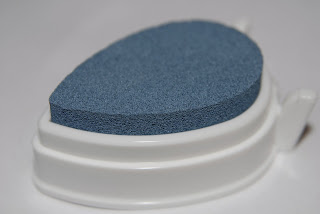b2b: inks...
I have been asked questions about inks recently, so I thought I would walk though the basic differences and uses for the most common crafting inks.
Pigment:
These inks come in a spongey foam ink pad. They have a thicker consistency, and are generally more opaque. They stay wet for long enough that you can use them as an embossing ink. They are great for stamping with clear stamps because the ink will not bead. They work best on porous surfaces such as regular paper and cardstock. Some brands will not dry on surfaces like glossy paper (however if you use an embossing powder over them, they work fine)
Chalk inks are pigment inks that dry to a matte finish.

Dye:
These inks will come in a felt pad. They have a thinner consistency, and are semi-translucent. They dry quickly and therefor are not good for embossing. You can watercolor with these inks by rubbing the pad on a non-porous surfaced (like an acrylic block) and using a water brush to paint your color. They do not always work well with clear stamps. This is because some clear stamps resist some brands of dye inks causing it to bead and the image to stamp very blotchy. To fix this, try scruffing up the surface of your stamp with an eraser or nail file. If this doesn't help, try adding embossing ink... see below. They can also be applied using a FOAM blending tool/applicator. These can be used on glossy paper. *please note: I am talking about clay based glossy paper like the kind from Ranger. They will not work the same on photo paper!*
Some dye inks (like Archival Ink by Ranger) are "water-resistant". This means that once the image is dry, it won't smear with water. This allows you to color images in with markers without your lines bleeding

Tim Holtz Distress Ink:
Technically these are dye inks. However there are some differences. They are designed to blend well. They are translucent so they layer well (both on top of each other, and over printed/stamped paper). They are specially formulated to work well with water. You can watercolor with them like regular dye inks. If you apply a layer of ink, than flick water droplets at it, you can get a really neat effect. They are also designed to stay wet long enough that you can emboss with them.

Embossing ink:
This comes in either clear or tinted. It is used for heat embossing. It is a thick sticky formula that stays wet for a fair amount of time. You can also use it to allow embossing with dye inks, and fixing the problem of beading on clear stamps. To emboss with dye inks, ink up your stamp with your embossing ink, then ink the stamp in your dye ink, then stamp. Cover with powder, and heat like normal. Having the embossing ink under the dye ink will not hurt your dye ink pad, and will keep the ink wet enough to allow for embossing. If your dye ink is beading on a clear stamp, ink your stamp in the embossing ink, then the dye ink, then stamp. Allow to dry. The embossing ink gives the dye ink something to stick to so you get better coverage, and less beading.

Solvent:
The best known of this kind is Staz-on. They can be used for most surfaces including acrylic, acetate, paper, metal, and plastic. Staz-on makes a special stamp cleaner that can be used to help get the ink off your stamps and acrylic blocks. It can take some time to dry, so you need to be careful not to touch it too quickly to avoid smearing.

Alcohol:
These don't come in ink pads, but in little bottles. They are good for non-porous surfaces such as glossy paper, metal, plastic, and glass. They are translucent. They can be applied using a FELT blending tool, fillable alcohol ink markers (by Ranger), or with a water brush filled with blending solution. The blending solution is used to blend, lighten, and remove Alcohol inks. This is a good ink to use if you want to change the color of your rhinestones, brads, eyelets, etc.

I hope that gives you a basic idea about the different inks, and what they are used for. If you have any questions, let me know, and I will be happy to answer them.
~Kassi
Kassi,
ReplyDeleteThanks for the info. With so many inks and so many brands it can be a bit confusing.
Stacy
Thank you so much....I really needed this...I don't stamp much but I do use inks for some things
ReplyDelete